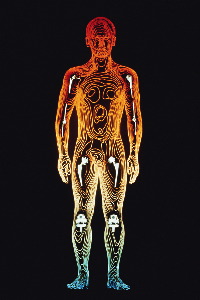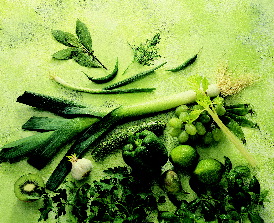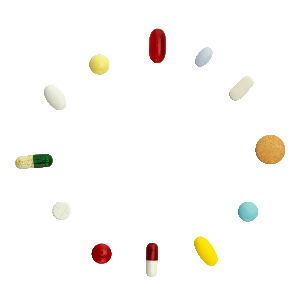Naturopathic health
Detox and diet - putting energy back into your life
DetoxificationMost of us know someone who has tried a detox programme of some sort or another, often just over a weekend or few days and often with very mixed results. The purpose of a detox is to unburden your body, by eating very simple foods and drinking water, and allowing it the chance to break down and eliminate the toxins it has built up over the years, and spend time repairing and rejuvenating the body’s tissues. (About 50% of our body’s energy is used up during digestion – no wonder we are so tired all of the time!) The most important detoxification organ in the body is the liver, but it is important that all of the body’s organs are functioning efficiently before starting a detox programme so that wastes do not accumulate. For example, if a person is constipated, toxins from the colon can be re-absorbed back into the blood and this will create more work for the liver as it has to break the toxins down. It can also be seen that when one organ is congested, the body will eliminate toxins vicariously, eg through the skin (acne). |
Detoxification
|
|
|
People who launch themselves into fasting-type detox plans, often complain after a few days that they feel worse for eating healthily and not drinking coffee and alcohol. They are experiencing what is known as a “Healing Crisis”. As they unburden their body of new toxins, the body starts to mobilise all the toxins it has stored over the years out of the fat deposits, and into the blood stream to be broken down by the liver – it is the release of these toxins that bring on the symptoms of the healing crisis: headaches, foggy feeling in the head, lethargy, tiredness and nausea. These unpleasant side effects pass after a few days, and leave you feeling revitalised and full of energy. However, a full detox can take in the region of eight weeks depending on the severity of the toxin build up. Before embarking on a detox programme there are a few things that are worth considering... Is this your busiest time at work? Do you have any dinners to attend, or parties or weddings etc? Do you have exams coming up? Are you about to go on the holiday? Is this the right time for you to embark on a detox programme? Detoxification methods1 DietThe idea is to take the load off the body by giving it nutritious but simple foods to digest. For example, eating brown rice, fish, fruit and vegetables. Cutting out all dairy and wheat products, including eggs. Drinking plenty of pure bottled water. Recipes that are suitable for detoxification programmes are included in our healthy recipes section. We have also recommended some detox books at the bottom of the page |
|
|
|
2 JuicingFreshly made juices, either fruit or vegetable are full of vitamins and minerals, that are in a readily available form for the body to utilise. There are many types of juicer on the market now, and at affordable prices. The centrifugal juicers are very good. There are websites that compare the various features, such as how easy it is to clean, Fruit juices are more cleansing than vegetable juices. Fruit juices are best consumed in the mornings when digestion is at its highest point, and vegetable juices are best taken later in the day between meals. It is generally advisable to not mix fruits and vegetables when juicing as this can lead to build up of gases and impaired digestion. However, apples can be mixed with any vegetable and carrots can be mixed with any fruit. (Dried fruits should not be mixed with juices.) Beetroot is especially supportive for the liver and is a good cleanser Juicing recipes are available on the website and those that are especially good for particular detoxification programmes are marked accordingly |
juicing recipes
|
|
3 Supplements
There are various supplements that support the body through a detox programme, some support the liver specifically and others aid the digestion and ensure the regular transit of food through the digestive tract, to avoid constipation. For a full list of detox supplements and an explanation of their effect on the body, click on the supplements link. Some examples of detox supplements are: Milk Thistle – encourages the flow of bile from the liver, which aids in the breakdown of fats. It also is said to protect the liver cells and encourage their regeneration. Dandelion – the dried root can be bought in the form of a “coffee”. Dandelion aids contraction of the gall bladder and hence the flow of bile, to help in the digestive process. It also helps to decongest the liver, by cleansing the liver cells. Psyllium Husks – contain soluble fibre and mucilaginous compounds to ensure the regular transit of faeces through the digestive system to prevent constipation.
|
more about supplements
|
|
4 Exercise & Skin BrushingExercise moves the blood around the body and carries oxygen and nutrients, which aids healing. Contraction of the muscles during exercise aids the flow of lymph, which carries waste products from the body tissues to eventually join the blood stream to be eliminated. Exercise initiates the release of endorphins (“happy chemicals”) which have a positive effect on your emotional wellbeing. For the first few days of the detox, you may just feel like curling up and hibernating, but once these feelings subside you will have more energy. To ensure that the toxins your body is trying to eliminate do not stagnate, it is important to make sure you include some exercise in your daily routine – e.g. Yoga, stretching, going to the gym, walking, rebounding and of course Qi Gong. Skin brushing with a stiff brush is a very good way of moving the lymph – always brush in the direction of the heart. It also removes dead skin cells that may be clogging up the pores and hindering elimination via the skin. Massage encourages the movement of lymph and hence the mobilisation of toxins. |
More about Qi Gong
|
|
5 Saunas and bathsSaunas promote sweating, allowing the body to eliminate toxins. Adding Epsom Salts to a bath creates an alkaline environment to mobilise acids out of the tissues. Care needs to be taken with very hot baths during a detox. Always make sure there is someone around to check on you.
|
massage therapies |
|
|
Suggested reading: There are a great deal of detox plans, but two that Naturopathic Health would recommend are “The Liver Detox Plan” by Xandria Williams and “Detox Handbook” by Dr Jennifer Harper.
|
||
|
Do you know interesting recipes that can be used as part of a detox diet? If so, click the links on our healthy recipes or juicing pages and submit your ideas Healthy Recipes Juicing Supplements ExerciseBach Flower Herbal Acupuncture Homeopathy DetoxificationMassage Qi Gong Nutrition & Diet Iridology Tissue Salts |

[Herbal Remedies][Ailments][Naturopathy][Contact][Community][Lifestyle][Home][Research]










